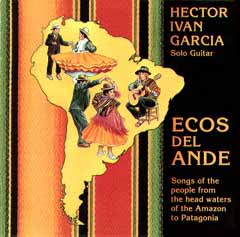
|
THE SELECTIONS |
Hector Ivan Garcia Ecos Del Ande JS 103 Musical Traditions of South AmericaThe beautiful music of modern South America is the result of the cultural blending that occurred when the invading Europeans and imported Africans mixed with the native population. The wide variety of styles was determined by economics and geography. European influence on native rhythms and harmonies was strongest near the coasts, with African sounds more influential where imported slave labor was used. The music of the high Andes remains much closer to the original native traditions due to the protective inaccessibility of the mountains. The Spanish guitar, easily tuned and portable, was soon adopted by the natives and is now the favorite instrument of South America. Twentieth century South American composers have been deeply influenced by the classical guitar repertoire. Such renowned artists as Barrios, Villa-Lobos, and Lauro are foremost examples of the evolution of South American music. Their works, now part of the standard classical guitar repertoire, are filled with the rich harmonies and exciting rhythms of South America. The selections Danza Serrana and Ecos del Ande are original compositions by Mr. Garcia and are based on traditional dance rhythms. Sons de Carrillos was composed by Joao Teixeira Guimaraes, La Cumparsita by G.H. Matos Rodriguez and Vals Venezolano #3 by Antonio Lauro. All other selections are traditional dances arranged for solo guitar by Mr. Garcia. The various rhythms (cumbia, pasillo, etc.) remain popular throughout South America today. Mr. Garcia's arrangements benefit from his musical training and mastery of classical technique without obscuring the direct emotional impact common to traditional folk music. |
EL CABALLO VIEJO (THE OLD HORSE) The cumbia of Colombia mixes the lighthearted spirit of the Caribbean with the soulful romance of South America. The lyric to this piece sings the spirit of an old man who finds himself, perhaps for the last time, in the company of a young woman.
VALS VENEZOLANO #3 ANTONIO LAURO This waltz from Venezuela has become an important part of the modern repertoire for classical guitar. It is a fine example of the wonderful works that spring from the mixing of people and cultures. This blend of native, European and African sounds is now recognized the world over as the music of South America, the heart of modern guitar.
SOMBRAS (SHADOWS) The deeply melancholic pasillo is a popular Ecuadorian dance which speaks of the sadness we all share in being aware of so many paths but having to choose just one. The lyric to this piece describes the shadow which is cast forever over the heart of one who must leave a lover behind.
GALERON The joyous Caribbean influences evident in this rhythm from Colombia and Venezuela offer an almost irresistable invitation to get up and move to the beat.
ALMA LLANERA (SOUL OF THE PLAINS) The joropo is a dance originally from Venezuela. This particular song is very popular throughout South America with differences of interpretation occurring in each country and each generation.
LA CUMPARSITA G.H.MATOS RODRIGUEZ The tango evolved early in the twentieth century in Argentina and is rooted in French and Spanish styles with a special spice from the Argentinian Creole society. This wonderfully robust tango has been very popular for many years.
GALOPERA This beautiful and lively folk dance represents well the warm, soulful music of landlocked Paraguay. The unique harp that inspired the wide open, ringing melody of this piece is the most prominent instrument of Paraguay.
LA PALOMITA (LITTLE DOVE) This traditional folk style of Argentina and Chile makes use of the brief, lovely melodic phrases indicative of a people to whom singing is as natural as walking. This arrangement has developed through three generations of Mr. Garcia's family.
VALS PERUANO This Peruvian waltz blends native and African rhythms into a European waltz. African culture has exercised a very strong influence over the music of South America as it has that of North America.
ECOS DEL ANDE (ECHOES OF THE ANDES) HECTOR GARCIA This piece starts as an Andean lament then changes to the upbeat huayno rhythm of the Incas. The harmonies are inspired by the charango, a native adaptation of the Spanish guitar.
SONS DE CARRILLOS (SOUNDS OF BELLS) JOAO TEIXEIRA GUIMARAES This choro shares a rich harmony and joyously complex rhythm with the other heavily African influenced styles of Brazil.
VILLANCICO This robust Peruvian huayno in celebration of Christmas is an excellent example of the adaptation of a Spanish tradition by the Incan culture.
YO VENDO UNOS OJOS NEGROS (I SELL SOME BLACK EYES) The Chilean version of the cueca, despite the reference in this particular song to the dark eyes of a lost love, is generally brighter than Bolivian examples of this traditionally romantic form.
DANZA SERRANA (MOUNTAIN DANCE) HECTOR GARCIA The Incan huayno rhythm, prominent from Argentina to Ecuador, has survived in the high Andes relatively free of external influence. This rhythm has been passed from generation to generation in Mr. Garcia's family making every huayno he composes another link with his Andean ancestors.
